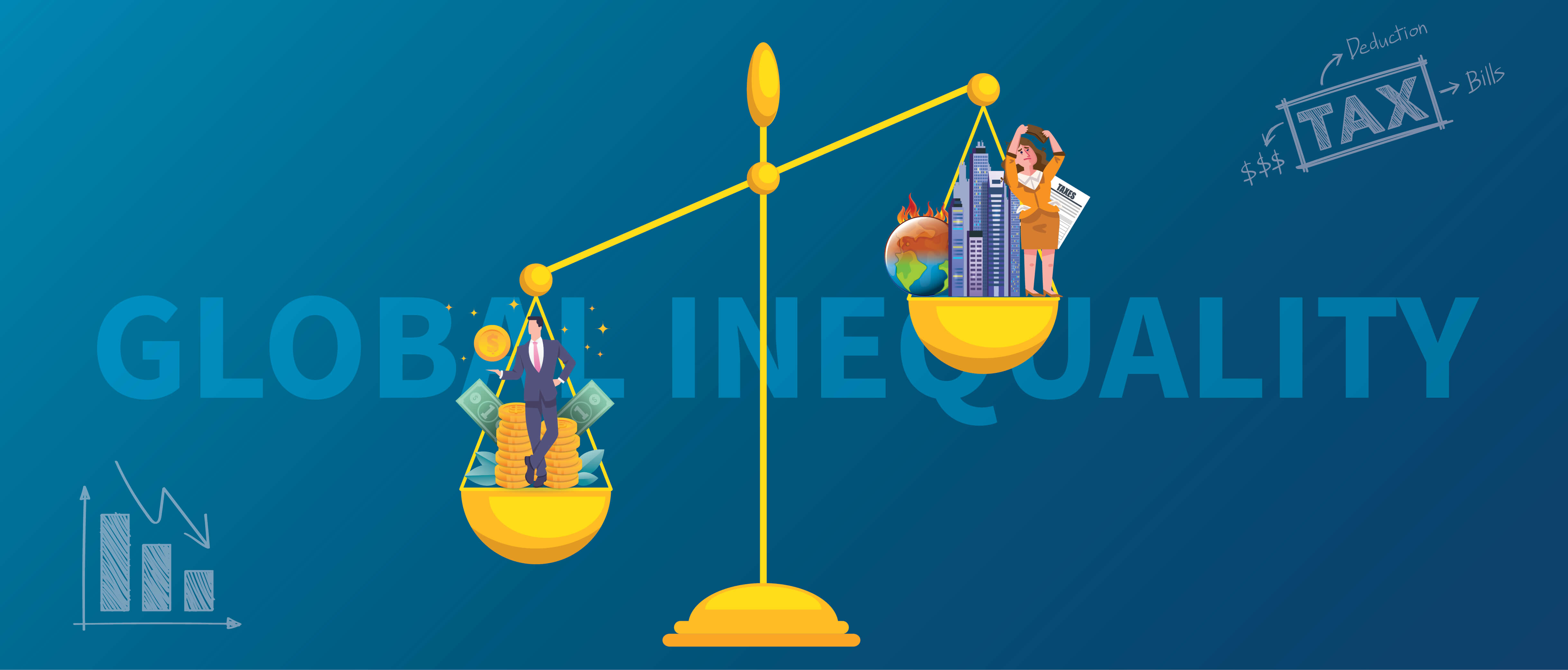Global Inequality: Rising Tide
February 5, 2020 | Expert Insights

Background
International Inequality is defined as signalling the systematic inequalities that exist between countries. In comparison, Global Inequality is the economic differences between people across countries and encompasses differences in medical care and educational opportunities. GDP of the individual country is the prime measure for international Inequality, although other aspects like wealth, life expectancy and gender inequalities are also taken into account.
In 1975, the developed world was ten times richer than the poor and developing world. Forty years later, while the gap between the wealth of countries of the world has narrowed, this newfound wealth in both developing and developed countries has not been distributed equally internally.
Global Multidimensional Poverty Index (MPI), developed by Oxford Poverty & Human Development Initiative in 2018 counted 1.3 billion people who came in the MPI category, and their distribution worldwide was- 42% in Sub Saharan Africa, 41% in South Asia, 8.8% in East Asia & Pacific, 3% in Latin America and the Caribbean and 0.3% in Europe and Central Asia.
Analysis
Global Inequality takes us back a few hundreds of years to show that inequality moves in cycles, triggered by conflicts and diseases, by technological advancements and disparity in education and knowledge. The ongoing technological revolution has led to a spurt in Inequality in the West, reminiscent of the Industrial Revolution of 150 years ago.
The good news is that while within nations inequality may have risen, amongst nations the gap has reduced dramatically, as the middle class in China and India has risen closer to the stagnating income of the middle class of the developed world.
The causes of Global Inequality are manifold. These include the geography of the region, its colonial past which strangled growth, a dysfunctional political system, unfettered population growth, political and social schisms leading to conflicts and disasters like famines, floods, earthquakes to which some countries may be more vulnerable. ( This Para was too long )
United Nations Department of Economic and Social Affairs (UNDESA) has identified four megatrends which impact global inequality - technological innovation, climate change, urbanisation and international migration.
Technology, by itself, is an engine of growth as it opens up new possibilities in productivity and growth. But those who hold the IPRs, guard it jealously and share it at a price. Technology is known to create disruptions leading to job losses and wage inequality. It is being predicted that digitisation and AI will disrupt existing processes to the extent that a large number of workers will be rendered surplus.
Climate change effects are being accelerated especially in the poorest countries- Syria's prolonged droughts, South Asia's unpredictable monsoon patterns, SE Asia's deadly cyclones are prime examples. The rich are the primary polluters but the poor suffer the most.
Urbanisation has no doubt opened up unmatched opportunities and high quality of life, but its benefits are very selectively distributed. Prosperity and poverty live close together in metropolises making the inequality even starker. The rising exodus from rural areas to urban centres is not a sign of progress but of distress.
international migration gave the world opportunities to seek a better life. Today's rich countries are a testimony to this fact. If permitted in a controlled manner, it could mitigate Global Inequality. However, the reality is that the world is increasingly shutting doors on migrants.
Fiscal policies, legislation and international cooperation if used in a coordinated manner can mitigate the rising inequality.
India Watch
Though India is one of the fastest-growing economies; it is also one of the most unequal ones. The total wealth of Indian billionaires was larger than the 2019 FY union budget with the top 1% of the population, controlling 42.5% of the national wealth.
Assessment
- Global debts of the poorer countries are on the rise, and richer countries need to see how this can be addressed. Islands of prosperity surrounded by a sea of misery will not make this world a safer or better place to live- for both the rich and the poor.
- Whether the megatrends affecting wealth are harnessed to encourage a more equitable and sustainable world, or allowed to exacerbate disparities and divisions, will largely determine the shape of our common future.
- Government and policymakers must tax income proportionally to reduce inequality. It is possible, to end extreme poverty, by taxing wealth and high incomes.
- Universal Basic Income, for those without a steady income, under which the government will transfer a stipulated income to the bank account of its citizens can be considered. This will serve as a mean of social security.
- Income inequality is not inevitable- governments across the world, have to do more to address the issue. Fair tax policy, education and health policies paired with effective implementation can favour an equal social justice that in turn empowers a sustained growth of a nation.
“Inequality in a rapidly changing world comes as we confront the harsh realities of a deeply unequal global landscape. In North and South alike, mass protests have flared up, fuelled by a combination of economic woes, growing inequalities and job insecurity. Income disparities and a lack of opportunities are creating a vicious cycle of inequality, frustration and discontent across generations.”
UNDESA- 2020 report
Image Design: Chris Karedan, Synergia Foundation








Comments